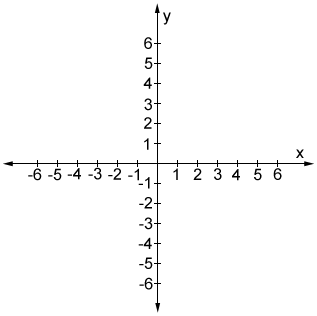What Scale Would Be Appropriate To Graph The Data
Graph calibration
A graph scale, or merely scale, refers to a gear up of numbers that indicate sure intervals on a graph used for measurement. In that location are many unlike types of graphs, including bar graphs, histograms, line graphs, and many more than. Scales tin can present differently based on the types of graphs involved.
In full general, the calibration of the graph can differ between axes, just within an axis, such as on the x-axis of the coordinate aeroplane, each interval represents the same value. Near typically, each mark on the x- and y-axes of the coordinate aeroplane represents 1 unit, as shown in the figure below.

Information technology is also possible to have dissimilar scales on each centrality. For example, each interval on the y-centrality could correspond ii, or even x units, while each interval on the x-axis represents one unit. As long as the intervals have consistent magnitudes within each axis (i.e. the interval is 1 throughout the entire x-axis for a given graph), the scale of each axis can be very dissimilar.
If for example, we graphed a point on the coordinate aeroplane at (1, 1), but each marking on the y-axis represented m units while each mark on the 10-axis represented 1 unit of measurement, we would not actually be able to see the point we graphed since the calibration of the y-axis is far too large. On the other mitt, if we were trying to graph the point (1, 1000), but used a scale such that each interval on the y-axis was 1 unit, the graph would have to extend very far along the y-axis, which is not practical. Instead, we could scale the axes such that the ten-axis has intervals of ane unit, while the y-axis has intervals of g units (or even 500, 200, etc.). Every bit long as the interval is sufficiently large, we would withal exist able to fit the graph within a reasonable area of the page we are working on.
A coordinate plane is only one case of graph scales; there are numerous others. However, the aforementioned principles can be carried through many different types of graphs. Below is an instance of a line graph in which the x-centrality and y-centrality have dissimilar intervals that are specifically called to ensure that the data presented is clear.

Although most basic graphs use a linear scale, it is worth noting that there are as well different types of scales, such as logarithmic scales. A logarithmic scale is i in which each interval represents the subsequent power of x. On a logarithmic calibration, the numbers 10 and 100, and thirty and 300 are equally spaced (in a linear scale, 10 and 20, and 30 and 60, would be equally spaced). Logarithmic scales are useful when trying to concisely display information over a range of values in which the largest value is much larger than the smallest.
Because there are so many ways to present information, information technology is of import to understand what blazon of graph(south) to utilise, besides as what scale to use, in social club to most effectively present the data.
What Scale Would Be Appropriate To Graph The Data,
Source: https://www.math.net/graph-scale
Posted by: griffithabore1949.blogspot.com


0 Response to "What Scale Would Be Appropriate To Graph The Data"
Post a Comment